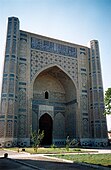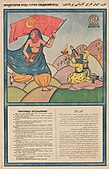Central Asian art
| History of art |
|---|
Central Asian art is
From the late second millennium BC until very recently, the grasslands of Central Asia – stretching from the Caspian Sea to central China and from southern Russia to northern India – have been home to migrating herders who practised mixed economies on the margins of sedentary societies. The prehistoric 'animal style' art of these pastoral nomads not only demonstrates their zoomorphic mythologies and shamanic traditions but also their fluidity in incorporating the symbols of sedentary society into their own artworks.
Central Asia has always been a crossroads of cultural exchange, the hub of the so-called
The arts of recent centuries are mainly influenced by Islamic art, but the varied earlier cultures were influenced by the art of China, Persia and Greece, as well as the Animal style that developed among the nomadic peoples of the steppes.[4] [6]
Upper Paleolithic

The first modern human occupation in the difficult climates of North and Central Asia is dated to circa 40,000 ago, with the early Yana culture of northern Siberia dated to circa 31,000 BCE. By around 21,000 BCE, two main cultures developed: the Mal'ta culture and slightly later the Afontova Gora-Oshurkovo culture.[7]
The
Bronze Age
The
Fertility goddesses, named "Bactrian princesses", made from limestone, chlorite and clay reflect agrarian Bronze Age society, while the extensive corpus of metal objects point to a sophisticated tradition of metalworking.[11] Wearing large stylised dresses, as well as headdresses that merge with the hair, "Bactrian princesses" embody the ranking goddess, character of the central Asian mythology that plays a regulatory role, pacifying the untamed forces.[citation needed]
-
Female figurine of the "Bactrian princess" type; between 3rd millennium and 2nd millennium BC; chlorite mineral group (dress and headdresses) and limestone (face and neck); height: 17.3 cm, width: 16.1 cm; Louvre
-
Ancient bowl with animals, Bactria, 3rd–2nd millennium BC.
-
Axe with eagle-headed demon & animals; late 3rd millennium-early 2nd millennium BC;gilt silver; length: 15 cm; Metropolitan Museum of Art(New York City)
-
Camel figurine; late 3rd–early 2nd millennium BC; copper alloy; 8.89 cm; Metropolitan Museum of Art
-
Handled weight; late 3rd–early 2nd millennium BC; chlorite; 25.08 x 19.69 x 4.45 cm; Los Angeles County Museum of Art (USA)
-
Female figurine of the "Bactrian princess" type; 2500–1500; chlorite (dress and headdresses) and limestone (head, hands and a leg); height: 13.33 cm; Los Angeles County Museum of Art (USA)
-
Beaker with birds on the rim; late 3rd–early 2nd millennium BC; electrum; height: 12 cm, width: 13.3 cm, depth: 4.5 cm; Metropolitan Museum of Art
Scythian cultures
Pazyrik culture (6th–3rd century BC)
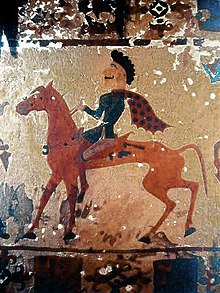
The
Other kurgan cemeteries associated with the culture include those of Bashadar, Tuekta, Ulandryk, Polosmak and Berel. There are so far no known sites of settlements associated with the burials, suggesting a purely nomadic lifestyle.
The remarkable textiles recovered from the Pazyryk burials include the oldest woollen knotted-pile carpet known, the oldest embroidered Chinese silk, and two pieces of woven Persian fabric (State Hermitage Museum, St. Petersburg). Red and ochre predominate in the carpet, the main design of which is of riders, stags, and griffins. Many of the Pazyryk felt hangings, saddlecloths, and cushions were covered with elaborate designs executed in appliqué feltwork, dyed furs, and embroidery. Of exceptional interest are those with animal and human figural compositions, the most notable of which are the repeat design of an investiture scene on a felt hanging and that of a semi-human, semi-bird creature on another (both in the State Hermitage Museum, St. Petersburg). Clothing, whether of felt, leather, or fur, was also lavishly ornamented.
Horse reins either had animal designs cut out on them or were studded with wooden ones covered in gold foil. Their tail sheaths were ornamented, as were their headpieces and breast pieces. Some horses were provided with leather or felt masks made to resemble animals, with stag antlers or rams' horns often incorporated in them. Many of the trappings took the form of iron, bronze, and gilt wood animal motifs either applied or suspended from them; and bits had animal-shaped terminal ornaments. Altai-Sayan animals frequently display muscles delineated with dot and comma markings, a formal convention that may have derived from appliqué needlework. Such markings are sometimes included in
Certain geometric designs and
-
Pazyryk carpet
-
Pazyryk saddlecloth.
Art of the steppes
Tribes of Europoid type appear to have been active in Mongolia and Southern Siberia from ancient times. They were in contact with China and were often described for their foreign features.[18]
-
Bronze plaque of a man of theCaucasoid features.[19]
-
Belt Buckle, Mongolia or southern Siberia, 2nd–1st century BC.[20]
-
The
Sakas

The art of the
Ancient influences from Central Asia became identifiable in China following contacts of metropolitan China with nomadic western and northwestern border territories from the 8th century BC. The Chinese adopted the Scythian-style animal art of the
Following their expulsion by the
Saka influences have been identified as far as Korea and Japan. Various Korean artifacts, such as the royal crowns of the kingdom of
-
"Kings with dragons",Tillia Tepe
-
Battle scenes on the Orlat plaques. 1st century AD.
-
Crown from Tomb VI of Tillya Tepe (female owner)
Achaemenid period

Under Persian rule, many Greeks were deported to Bactria, so that their communities and language became common in the area. During the reign of
Hellenistic and Greco-Bactrian art (265–145 BC)
The
The main known remains from this period are the ruins and artifacts of their city of
Architecture in Bactria
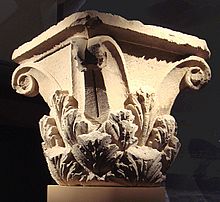
Numerous artefacts and structures were found, particularly in Ai-Khanoum, pointing to a high Hellenistic culture, combined with Eastern influences, starting from the 280–250 BC period.
Archaeological missions unearthed various structures, some of them perfectly Hellenistic, some other integrating elements of
-
Ai- Khanoum mosaic (central detail in color).
-
Architectural antefixae with Hellenistic "Flame palmette" design, Ai-Khanoum.
-
Sun dial within two sculpted lion feet.
-
Winged antefix, a type only known from Ai-Khanoum.
Sculpture
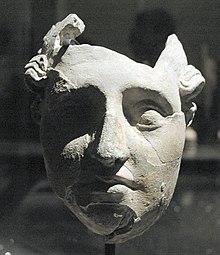
Various sculptural fragments were also found at Ai-Khanoum, in a rather conventional, classical style, rather impervious to the Hellenizing innovations occurring at the same time in the Mediterranean world. Of special notice, a huge foot fragment in excellent Hellenistic style was recovered, which is estimated to have belonged to a 5–6 meter tall statue (which had to be seated to fit within the height of the columns supporting the Temple). Since the sandal of the foot fragment bears the symbolic depiction of Zeus' thunderbolt, the statue is thought to have been a smaller version of the Statue of Zeus at Olympia.[47][48]
Due to the lack of proper stones for sculptural work in the area of Ai-Khanoum, unbaked clay and stucco modeled on a wooden frame were often used, a technique which would become widespread in Central Asia and the East, especially in Buddhist art. In some cases, only the hands and feet would be made in marble.
In India, only a few Hellenistic sculptural remains have been found, mainly small items in the excavations of Sirkap.
-
Sculpture of an old man. Ai-Khanoum, 2nd century BC.
-
Close-up of the same statue.
-
Frieze of a naked man wearing a chlamys. Ai-Khanoum, 2nd century BC.
-
Hellenistic gargoyle. Ai-Khanoum, 2nd century BC.
Artefacts
A variety of artefacts of Hellenistic style, often with Persian influence, were also excavated at Ai-Khanoum, such as a round medallion plate describing the goddess
-
Bronze Herakles statuette. Ai-Khanoum. 2nd century BC.
-
Bracelet with horned female busts. Ai-Khanoum, 2nd century BC.
-
Stone recipients from Ai-Khanoum. 3rd-2nd century BC.
-
Imprint from a mold found in Ai-Khanoum. 3rd-2nd century BC.
Yuezhi and Kushan art
Some traces remain of the presence of the Kushans in the areas of
Khalchayan (1st century BC)
The art of
According to Benjamin Rowland, the styles and ethnic type visible in Kalchayan already anticipate the characteristics of the later
Bactria (1st–3rd century AD)
The Kushans apparently favoured royal portraiture, as can be seen in their coins and their dynastic sculptures.
As the Kushans progressively adapted to life in India, their dress progressively became lighter, and representation less frontal and more natural, although they retained characteristic elements of their nomadic dress, such as the trousers and boots, the heavy tunics, and heavy belts.
-
Early Kushan ruler Heraios (1–30 AD), from his coinage.
-
Figures in the embroidered carpets of the Noin-Ula burial site, made in Bactria and proposed to represent Yuezhis (1st century BC – 1st century AD).[60][61][62]
-
Kushan men in caftan and boots, at Fayaz Tepe
-
Buddhist mural in Kara Tepe, 2nd–4th century AD.
-
Buddhist pillar capital from Surkh Kotal, with central Buddha figure.
Kushano-Sasanian art (3rd–4th century AD)
The
-
Kushano-Sasanian footed cup with medallion, 3rd-4th century AD, Bactria, Metropolitan Museum of Art.[68]
-
Possible Kushano-Sasanian plate, excavated in Rawalpindi, Pakistan, 350–400 AD.[69] British Museum 124093.[70][71]
-
Terracotta head of a male figure, Kushano-Sasanian period, Gandhara region, 4th–5th century AD
Huns
The
Both ancient sources and archaeological finds from graves confirm that the Huns wore elaborately decorated golden or gold-plated diadems.[77] Maenchen-Helfen lists a total of six known Hunnish diadems.[78] Hunnic women seem to have worn necklaces and bracelets of mostly imported beads of various materials as well.[79] The later common early medieval practice of decorating jewelry and weapons with gemstones appears to have originated with the Huns.[80] They are also known to have made small mirrors of an originally Chinese type, which often appear to have been intentionally broken when placed into a grave.[81]
Archaeological finds indicate that the Huns wore gold plaques as ornaments on their clothing, as well as imported glass beads.[82] Ammianus reports that they wore clothes made of linen or the furs of marmots and leggings of goatskin.[83]
-
A Hunnish cauldron
-
Detail of Hunnish gold and garnet bracelet, 5th century, Walters Art Museum
-
A Hunnish oval openwork fibula set with a carnelian and decorated with a geometric pattern of gold wire, 4th century, Walters Art Museum
Kidarites
The
-
Silver bowl, showing anAlchonhorseman
-
Two Kidarite princes on theHephthalite bowl
Hephthalite art (4th–6th century AD)
The Hephthalites (Bactrian: ηβοδαλο, romanized: Ebodalo),[95] sometimes called the "White Huns",[96][97] were a people who lived in Central Asia during the 5th to 8th centuries. They existed as an Empire, the "Imperial Hephthalites", and were militarily important from 450 AD, when they defeated the Kidarites, to 560 AD, date of their defeat to combined First Turkic Khaganate and Sasanian Empire forces.[98][99]
The Hepthalites appears in several mural paintings in the area of
The paintings related to the Hephthalites have often been grouped under the appellation of "Tokharistan school of art",
This "Hephthalite period" in art, with the caftans with a triangular collar folded on the right, the particular cropped hairstyle, the crowns with crescents, have been found in many of the areas historically occupied and ruled by the Hephthalites, in Sogdia, Bamiyan (modern Afghanistan), or in Kucha in the Tarim Basin (modern Xinjiang, China). This points to a "political and cultural unification of Central Asia" with similar artistic styles and iconography, under the rule of the Hephthalites.[108]
-
The banquet scenes in the murals of Balalyk Tepe show the life of the Hephthalite ruling class of Tokharistan.[109][103][104][100]
-
Banquet scene, Balalyk Tepe
-
Probable Hephthalite royal couple in the murals of the Buddhas of Bamiyan circa 600 AD (the 38-meter Buddha they decorate is carbon dated to 544–595 AD).[110]
-
Stamp seal with a bearded figure in Sasanian dress, wearing the kulāf denoting nobility and officials; and a figure with radiate crown,[111] both with royal ribbons. Attributed to the Hephthalites,[112] and recently dated to the 5th–6th century AD.[113] Stamp seal (BM 119999), British Museum.
Buddhist art of Bamiyan
The Buddhist art of Bamiyan covers a period from the early centuries of the Common Era, culminating with the building of the
The statues represented a later evolution of the classic blended style of
The Buddhas are surrounded by numerous caves and surfaces decorated with paintings.[120] It is thought that the period of florescence was from the 6th to 8th century AD, until the onset of Islamic invasions.[120] These works of art are considered as an artistic synthesis of Buddhist art and Gupta art from India, with influences from the Sasanian Empire and the Byzantine Empire, as well as the country of Tokharistan.[120]
-
Buddha, Cave 404 in Bamiyan.
-
Sun-God Surya on his chariot
-
Western Buddha, Niche, ceiling, east section E1 and E2.[123]
Tarim Basin

From the 3rd century AD, the Tarim Basin became a centre for the development of Buddhist art, and a major relay for the Silk Road transmission of Buddhism. Buddhist texts were translated into Chinese by Kuchean monks, the most famous of whom was Kumārajīva (344–412/5).[124][125]
Indian and Central Asian influences
Numerous Buddhist caves cover the northern side of the Tarim Basin, such as the Kizil Caves consisting in over 236 such temples. Their murals date from the 3rd to the 8th century.[126] The caves of Kizil are the earlier of their type in China, and their model was later adopted in the construction of Buddhist caves further east.[127] Other famous sites nearby are the Kizilgaha caves, the Kumtura Caves, Subashi Temple or the Simsim caves.[128][129]
In the Kizil Caves appear portraits of Royal families, composed of the King, Queen and young Prince. They are accompanied by monks, and men in caftan.[130]
-
Painting of a cowherd listening to a sermon of the Buddha, from the right wall of the main hall. Cave of the Statues.14C date: 406-425 AD.[132]
-
Dahlem Museum
Interaction with Chinese art
The influence of
-
Details from Praṇidhi scene No. 5. Central Asian and Asian Buddhist monks.[133]
-
Bodhisattva leading a lady donor towards the Pure Lands. Painting on silk (Library Cave), Late Tang. Mogao Caves
-
Figure ofMaitreya Buddha in cave 275 from Northern Liang (397–439), one of the earliest caves. The crossed ankle figure with a three-disk crown shows influence from Kushan art. Mogao Caves
Sogdian art
The
-
Rostam, with an elongated skull, Penjikent murals
Central Asian art in ancient China
From the 4th to the 6th centuries AD, the Northern dynasties (389–589 AD) of China, ruled by the nomadic Xianbei, engaged in trade with Central Asia, often through the intermediary of Sogdian traders. Northern Wei art came under influence of Indian and Central Asian traditions through the mean of these trade routes. This included the influence of Buddhism, which flourished under the Northern dynasties.[148] Numerous Central Asian works of art, especially decorated silverware and jewelry, have been found in the tombs of the Northern Wei, the Northern Qi or the Northern Zhou.[149][150][151]
Turkic art
The
-
Silver artifacts from Khakassia, associated wjth the Yenisei Kyrgyz people.[155]
-
Warrior statue; 8th–10th century; from theSankt Petersburg, Russia)
Islamic Golden Age in Central Asia
The
Arab period (7–8th centuries)
Islamic art diffused in Central Asia with the rule of
-
Folio sheet from a Qur'an, found in the sanctuary of Katta Langar, south of Samarkand, first half of the 8th century.
-
Coran from Katta Langar, decorative band (detail)
Iranian Intermezzo (9–10th centuries)
Samanids (819–999)
Artistic florescence occurred especially during the period of the Samanid Empire (819–999). The empire was centred in Khorasan and Transoxiana; at its greatest extent encompassing modern-day Afghanistan, large parts of Iran, Tajikistan, Turkmenistan, Uzbekistan, Kyrgyzstan, parts of Kazakhstan and Pakistan.
-
"Simurgh platter", from Iran, Samanids dynasty. 9th-10th century. Islamic Art Museum (Museum für Islamische Kunst), Berlin
Buyids (932–1062)
The
-
Medallion of Buyid amir 'Adud al-Dawla (r.936–983).
-
Gold ewer of the Buyid Period, mentioning Buyid rulerIzz al-Dawla Bakhtiyar ibn Mu'izz al-Dawla, 966-977 CE, Iran.[167]
-
Buyid silk in pseudo-Sasanian style.
-
Rosewater bottle, Buyid art, early 12th century, Iran. Freer Gallery of Art.[168]
Turkic dynasties (9–13th centuries)
With the rise of Turkic dynasties in Central Asia, Persian art started to evolve to adapt to the tastes of the new Turkic ruling class: in paintings, the composition of narrative scenes remains unchanged, but nomadic clothing, physical traits and power symbols (such as the bow and arrow) are now depicted. From the mid-12th century, beauty standards too evolve, with round and serene faces with almond-shaped eyes becoming uniquitous in artistic representations.[169]
Kara-Khanid Khanate (840-1212)
A palatial structure dating to the
-
Kara-Khanid bands of inscription with running animals, Afrasiab, circa 1200 CE.[175]
The
-
Ghaznavid portrait of a characteristically Turkic individual, Palace of Lashkari Bazar.[182]
-
Ghaznavid sculpted architecture, marble, Ghazni, 12th century AD
-
Vessel with bull's head spout, Ghaznavid dynasty, late 11th to early 12th century
-
Ghaznavid sculpted architecture, marble, Ghazni, 12–13th century AD
Seljuks (1037–1194)
The Seljuk Empire (1037–1194 AD) was a high medieval Turko-Persian Sunni Muslim empire, originating from the Qiniq branch of Oghuz Turks. At its greatest extent, the Seljuk Empire controlled a vast area stretching from western Anatolia and the Levant to the Hindu Kush in the east, and from Central Asia to the Persian Gulf in the south.
-
Mausoleum of Sultan Sanjar in Merv, Turkmenistan.
-
Seljuk-era art:Ewer from Herat, Afghanistan, dated 1180–1210 AD. Brass worked in repousse and inlaid with silver and bitumen. British Museum.
-
Abu Zayd al-Kashani, dated 1187 CE, Iran.[185]
Khwarazmians (1077–1231)

The
-
Horsemen, Mina'i ware, early 13th century, Iran.[190]
-
Mina'i Bowl with horserider, early 13th century, Iran.[191]
-
Mina'i Lobed bowl, early 13th century, Iran.[192]
Mongol invasion
The Mongols under Genghis Khan invaded Central Asia in the early 13th century. The unified Mongol Empire was succeeded by the Chagatai Khanate,[194] a Mongol and later Turkicized khanate.[195][196] that comprised the lands ruled by Chagatai Khan, second son of Genghis Khan and his descendants and successors. At its height in the late 13th century, the khanate extended from the Amu Darya south of the Aral Sea to the Altai Mountains in the border of modern-day Mongolia and China, roughly corresponding to the defunct Qara Khitai Empire.[197] Initially the rulers of the Chagatai Khanate recognized the supremacy of the Great Khan,[198] but by the reign of Kublai Khan, Ghiyas-ud-din Baraq no longer obeyed the emperor's orders.
Timurid Renaissance
During the mid-14th century, the Chagatais lost
-
Mausoleum of Khoja Ahmed Yasawi in Hazrat-e Turkestan, Kazakhstan. Timurid architecture consisted of Persian art.
-
Akhangan's tomb, where Gawhar Shad's sister Gowhartāj is buried. The architecture is a fine example of the Timurid era in Persia.
-
Façade ofBibi Khanym Mosque, Samarkand.
Khanate of Bukhara and Khanate of Khiva
The
-
Imamkuli-khan
-
The Registan and its three madrasahs. From left to right: Ulugh Beg Madrasah (Timurid, built 1417–1421), Tilya-Kori Madrasah (built 1646–1660) and Sher-Dor Madrasah (built 1619–1636).
-
Suzani (ceremonial hanging); late 1700s; cotton; 92 × 63; from Uzbekistan; Indianapolis Museum of Art (US)
Russian Turkestan (1867–1917)
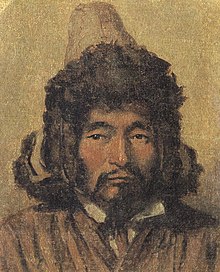
Central Asia fell largely under the control of Russia in the 19th century, following the
-
The Emir of Bukhara and the notables of the city watch how the heads of Russian soldiers are impaled on poles. Samarkand
-
Russian troops taking Samarkand in 1868
-
They Attack Unaware
Soviet Central Asia (1918–1991)
Soviet Central Asia refers to the section of Central Asia formerly controlled by the Soviet Union, as well as the time period of Soviet administration (1918–1991). Central Asian SSRs declared independence in 1991. In terms of area, it is nearly synonymous with Russian Turkestan, the name for the region during the Russian Empire. The first years of the Soviet regime saw the appearance of modernism, which took inspiration from the Russian avant-garde movement. Until the 1980s, Central Asian arts had developed along with general tendencies of Soviet arts.
-
Urging peasants to speed up cotton production – Russian and Uzbek, Tashkent, 1920s
-
"Female Muslims- The tsar, beys and khans took your rights away" – Azeri, Baku, 1921 (Mardjani).
-
Poster of 3 different men with the word "friendship" underneath. Central Asia
-
Emblem of theTurkmen SSR.
Contemporary period

In the 90s, arts of the region underwent some significant changes. Institutionally speaking, some fields of arts were regulated by the birth of the art market, some stayed as representatives of official views, while many were sponsored by international organizations. The years of 1990–2000 were times for the establishment of contemporary arts. In the region, many important international exhibitions are taking place, Central Asian art is represented in European and American museums, and the Central Asian Pavilion at the Venice Biennale has been organized since 2005.
See also
References
- ^ Inagaki, Hajime. Galleries and Works of the MIHO MUSEUM. Miho Museum. p. 45.
- .
- ^ Tamara Talbot Rice (July 2011). Visual Arts. Oxford.[full citation needed]
- ^ a b Encyclopædia Britannica, Central Asian Arts. 2012. Retrieved May 17, 2012. Encyclopædia Britannica.
- ISBN 978-0-7148-7502-6.
- S2CID 252909244.
- ^ a b Tedesco, Laura Anne. "Mal'ta (ca. 20,000 B.C.)". The Met's Heilbrunn Timeline of Art History. Metropolitan Museum of Art.
- ISBN 978-2733503362.
- ^ Karen Diane Jennett (May 2008). "Female Figurines of the Upper Paleolithic" (PDF). Texas State University. pp. 32–34. Retrieved 26 May 2016.
- ^ David Testen, "Old Persian and Avestan Phonology", Phonologies of Asia and Africa, vol. II (Winona Lake, Indiana: Eisenbrauns, 1997), 583.
- ISBN 978-0-7148-7502-6.
- ISBN 978-3-8438-0656-5.
- ^ (NOVA 2007)
- ^ (State Hermitage Museum 2007)
- ^ (Jordana 2009)
- Encyclopædia Britannica. Retrieved December 5, 2016.
- ^ Atwood, Christopher P.; Andreeva, Petya (2018). "Camp and audience scenes in late iron age rock drawings from Khawtsgait, Mongolia". Archaeological Research in Asia. 15: 4.
- ISBN 978-0-295-97473-6.
- ISBN 9780520015968.
- ^ ISBN 978-0-295-97473-6.
- ^ Prior, Daniel (2016). "Fastening the Buckle: A Strand of Xiongnu-Era Narrative in a Recent Kirghiz Epic Poem" (PDF). The Silk Road. 14: 191.
- ISBN 978-1-78969-648-6.
Inv. nr.Si. 1727- 1/69, 1/70
- ^ Francfort, Henri-Paul (1 January 2020). "Sur quelques vestiges et indices nouveaux de l'hellénisme dans les arts entre la Bactriane et le Gandhāra (130 av. J.-C.-100 apr. J.-C. environ)". Journal des Savants: 37.
- ^ Ollermann, Hans (22 August 2019). "Belt Plaque with a Bear Hunt. From Russia (Siberia). Gold. 220-180 B.C. The State Hermitage Museum, St. Petersburg, Russia".
- ISBN 9781351701587.
- ISBN 978-90-04-49151-9, retrieved 2024-01-03
- S2CID 240162003.
- ^ Mallory & Mair 2000.
- ISBN 2-87772-337-2
- ISBN 978-2-7118-5218-5
- ^ "金冠塚古墳 – Sgkohun.world.coocan.jp". Archived from the original on 2011-07-22. Retrieved 2010-12-14.
- ISBN 978-1-107-01652-1.
- ^ Herzfeld, Ernst (1968). The Persian Empire: Studies in geography and ethnography of the ancient Near East. F. Steiner. p. 344.
- ^ "BACTRIA – Encyclopaedia Iranica". www.iranicaonline.org. Retrieved 2019-08-07.
After annexation to the Persian empire by Cyrus in the sixth century, Bactria together with Margiana formed the Twelfth Satrapy.
- ^ Herodotus, 4.200–204
- ^ Strabo, 11.11.4
- ^ Herodotus 6.9
- ^ "Graeco-Bactrian Kingdom". Archived from the original on 2020-12-23. Retrieved 2021-02-15.
- ISBN 9782503524290.
- ^ ISBN 9788131716779.
- ISBN 9780520920095.
- ISBN 9788131716779.
- ISBN 9781588392244.
- ^ "It has all the hallmarks of a Hellenistic city, with a Greek theatre, gymnasium and some Greek houses with colonnaded courtyards" (Boardman).
- ISBN 9788131716779.
- ^ ISBN 9780520920095.
- ISBN 9780520242258.
- .
- ^ Source, BBC News, Another article. German story with photographs here (translation here).
- ^ Fedorov, Michael (2004). "On the origin of the Kushans with reference to numismatic and anthropological data" (PDF). Oriental Numismatic Society. 181 (Autumn): 32. Archived from the original (PDF) on 2019-10-06. Retrieved 2021-02-15.

- ^ KHALCHAYAN – Encyclopaedia Iranica. p. Figure 1.
- ^ "View in real colors".
- ^ Abdullaev, Kazim (2007). "Nomad Migration in Central Asia (in After Alexander: Central Asia before Islam)". Proceedings of the British Academy. 133: 87–98.
- ^ Foundation, Encyclopaedia Iranica. Greek Art in Central Asia, Afghan – Encyclopaedia Iranica.
- ^ Also a Saka according to this source
- ^ JSTOR 20111029.
- ^ a b "The knights in chain-mail armour have analogies in the Khalchayan reliefs depicting a battle of the Yuezhi against a Saka tribe (probably the Sakaraules). Apart from the chain-mail armour worn by the heavy cavalry of the enemies of the Yuezhi, the other characteristic sign of these warriors is long side-whiskers (...) We think it is possible to identify all these grotesque personages with long side-whiskers as enemies of the Yuezhi and relate them to the Sakaraules (...) Indeed these expressive figures with side-whiskers differ greatly from the tranquil and majestic faces and poses of the Yuezhi depictions." Abdullaev, Kazim (2007). "Nomad Migration in Central Asia (in After Alexander: Central Asia before Islam)". Proceedings of the British Academy. 133: 89.
- ^ ISBN 978-0205873470.
- ^ Puri, Baij Nath (1965). India under the Kushāṇas. Bharatiya Vidya Bhavan.
- ^ Yatsenko, Sergey A. (2012). "Yuezhi on Bactrian Embroidery from Textiles Found at Noyon uul, Mongolia" (PDF). The Silk Road. 10.
- ^ Polosmak, Natalia V. (2012). "History Embroidered in Wool". SCIENCE First Hand. 31 (N1).
- ^ Polosmak, Natalia V. (2010). "We Drank Soma, We Became Immortal…". SCIENCE First Hand. 26 (N2).
- ^ "Panel with the god Zeus/Serapis/Ohrmazd and worshiper". www.metmuseum.org. Metropolitan Museum of Art.
- ISSN 0065-0536.
- ^ Rezakhani, Khodadad (2021). "From the Kushans to the Western Turks". King of the Seven Climes: 204.
- ^ Rezakhani 2017, p. 72.
- ^ The Cambridge History of Iran, Volume 3, E. Yarshater p.209 ff
- ^ "Metropolitan Museum of Art". www.metmuseum.org.
- ISBN 978-3-447-05937-4.
- ^ "Plate British Museum". The British Museum.
- ISBN 978-0-300-09038-3.
- ^ Thompson 1996, pp. 6–7.
- ^ Maenchen-Helfen 1973, p. 306.
- ^ Maenchen-Helfen 1973, pp. 321–322.
- ^ Maenchen-Helfen 1973, p. 307-318.
- ^ Maenchen-Helfen 1973, p. 323.
- ^ Maenchen-Helfen 1973, p. 297.
- ^ Maenchen-Helfen 1973, pp. 299–306.
- ^ Maenchen-Helfen 1973, p. 357.
- ^ Kim 2015, p. 170.
- ^ Maenchen-Helfen 1973, pp. 352–354.
- ^ Maenchen-Helfen 1973, pp. 354–356.
- ^ Thompson 1996, p. 47.
- ^ The Cambridge Companion to the Age of Attila, Michael Maas, Cambridge University Press, 2014 p.284 ff
- ^ Encyclopedia Iranica
- ISBN 978-94-93194-00-7.
- ISBN 978-94-93194-00-7.
- ^ Cribb 2010, p. 91.
- ^ ISBN 9789231032110.
- ^ KURBANOV, AYDOGDY (2010). THE Hephthalites: Archeological and Historical Analysis (PDF). Berlin: Berlin Freie Universität. pp. 135–136.
- ^ "DelbarjīnELBARJĪN – Encyclopaedia Iranica". www.iranicaonline.org.
- ^ Ilyasov, Jangar. "The Hephthalite Terracotta // Silk Road Art and Archaeology. Vol. 7. Kamakura, 2001, 187–200": 187–197.
{{cite journal}}: Cite journal requires|journal=(help) - ISBN 978-92-3-103211-0.
- ISBN 978-3700168973.
- ISBN 978-92-3-103211-0.
- ISBN 978-0-521-84925-8.
- ISBN 978-0-297-85760-0.
- ^ Rezakhani, Khodadad (2021). "From the Kushans to the Western Turks". King of the Seven Climes: 208.
- ISBN 978-1-316-29830-5.
- ^ ISBN 978-0-520-03765-6.
- ^ "Il'yasov's article references figurines wearing caftans with triangular-shaped collars on the right side. This is believed to be a style of garment that became popular in Central Asia under Hephthalite rule" in Kageyama, Etsuko (2016). "Change of suspension systems of daggers and swords in eastern Eurasia: Its relation to the Hephthalite occupation of Central Asia" (PDF). ZINBUN. 46: 200.
- ^ ISBN 978-3-642-30051-6.
- ^ ISBN 978-0-520-03765-6.
- ^ a b Kurbanov, Aydogdy (2010). The Hephthalites: Archaeological and Historical Analysis (PDF) (PhD thesis). Free University, Berlin. p. 67.
- ^ Kurbanov, Aydogdy (2014). "THE HEPHTHALITES: ICONOGRAPHICAL MATERIALS" (PDF). Tyragetia. VIII: 322.
- ^ Il'yasov, Jangar Ya. (2001). "The Hephthalite Terracotta // Silk Road Art and Archaeology". Journal of the Institute of Silk Road Studies. 7. Kamakura: 187.
- ISSN 0240-8910.
- S2CID 130640638. Archived from the original (PDF) on 2020-11-11.)
{{cite journal}}: CS1 maint: multiple names: authors list (link - ISBN 978-1-4381-0996-1.
- ^ a b Eastern Buddha: 549 AD - 579 AD (1 σ range, 68.2% probability) 544 AD - 595 AD (2 σ range, 95.4% probability). Western Buddha: 605 AD - 633 AD (1 σ range, 68.2%) 591 AD - 644 AD (2 σ range, 95.4% probability). in Blänsdorf, Catharina (2015). "Dating of the Buddha Statues – AMS 14C Dating of Organic Materials".
{{cite journal}}: Cite journal requires|journal=(help) - ISBN 978-3700168973.
- ^ KURBANOV, AYDOGDY (2010). THE HEPHTHALITES: ARCHAEOLOGICAL AND HISTORICAL ANALYSIS (PDF). Berlin: Berlin Freie Universität. p. 69, item 1).
- JSTOR 24049013.. According to earlier sources (Bivar (1969) and Livshits (1969), repeated by the British Museum the seal was dated to the 300-350 CE: in Naymark, Aleksandr. "SOGDIANA, ITS CHRISTIANS AND BYZANTIUM: A STUDY OF ARTISTIC AND CULTURAL CONNECTIONS IN LATE ANTIQUITY AND EARLY MIDDLE AGES" (PDF): 167. Archived from the original (PDF) on 2021-02-27. Retrieved 2021-02-15.. The British Museum.
{{cite journal}}: Cite journal requires|journal=(help), "Stamp-seal; bezel British Museum" - ^ Blänsdorf, Catharina (2015). "Dating of the Buddha Statues – AMS 14C Dating of Organic Materials".
{{cite journal}}: Cite journal requires|journal=(help) - ^ a b Petzet, Michael, ed. (2009). The Giant Buddhas of Bamiyan. Safeguarding the remains (PDF). ICOMOS. pp. 18–19. Archived from the original (PDF) on 2023-02-04. Retrieved 2021-02-16.
- ^ Gall, Carlotta (5 December 2006). "Afghans consider rebuilding Bamiyan Buddhas". International Herald Tribune/The New York Times. Retrieved 8 March 2014.
- ISBN 978-8120800304. Retrieved 2 June 2009 – via Google Books.
- ^ "booklet web E.indd" (PDF). Retrieved 9 October 2013.
- ^ Gall, Carlotta (6 December 2006). "From Ruins of Afghan Buddhas, a History Grows". The New York Times. Retrieved 6 January 2008.
- ^ JSTOR 125086.
- ^ Alram, Michael; Filigenzi, Anna; Kinberger, Michaela; Nell, Daniel; Pfisterer, Matthias; Vondrovec, Klaus. "The Countenance of the other (The Coins of the Huns and Western Turks in Central Asia and India) 2012-2013 exhibit: 14. KABULISTAN AND BACTRIA AT THE TIME OF "KHORASAN TEGIN SHAH"". Pro.geo.univie.ac.at. Kunsthistorisches Museum Vienna. Archived from the original on January 25, 2021. Retrieved July 16, 2017.
- ^ "The globelike crown of the princely donor has parallels in Sasanian coin portraits. Both this donor and the Buddha at the left are adorned with hair ribbons or kusti, again borrowed the Sasanian royal regalia" in Rowland, Benjamin (1975). The art of Central Asia. New York, Crown. p. 88.
- ^ "Lost, Stolen, and Damaged Images: The Buddhist Caves of Bamiyan". huntingtonarchive.org.
- ^ Walter (1998), pp. 5–9.
- ^ Hansen (2012), p. 66.
- ^ Walter (1998), pp. 21–17.
- ISBN 978-7-5314-6376-4.
- ISBN 978-1-4008-4805-8.
- JSTOR 29757697.
- ^ References BDce-888、889, MIK III 8875, now in the Hermitage Museum."俄立艾爾米塔什博物館藏克孜爾石窟壁畫". www.sohu.com (in Chinese).
- ISBN 978-90-04-39186-4.
- ^ Waugh, Daniel (Historian, University of Washington). "Kizil". depts.washington.edu. Washington University. Retrieved 30 December 2020.
{{cite web}}: CS1 maint: multiple names: authors list (link) - ^ a b von Le Coq, Albert. (1913). Chotscho: Facsimile-Wiedergaben der Wichtigeren Funde der Ersten Königlich Preussischen Expedition nach Turfan in Ost-Turkistan
- ISBN 0-520-03765-0.
- ISBN 0-520-03765-0.
- ISBN 0-520-03765-0.
- ISBN 978-1-932476-13-2.
- ^ Compareti (University of California, Berkeley), Matteo (2007). "The Chinese Scene at Afrāsyāb". Eurasiatica.
- ISBN 978-1-83860-868-2.
- ISBN 978-1-932476-13-2.
- ^ Grenet, Frantz (2004). "Maracanda/Samarkand, une métropole pré-mongole". Annales. Histoire, Sciences Sociales. 5/6: Fig. D.
- ^ Compareti (University of California, Berkeley), Matteo (2015). "Ancient Iranian Decorative Textiles". The Silk Road. 13: 38.
- ^ "Hermitage Museum".
- ^ Gorelik, Michael (1979). "Oriental Armour of the Near and Middle East from the Eighth to the Fifteenth Centuries as Shown in Works of Art", by Michael Gorelik, in: Islamic Arms and Armour, ed. Robert Elgood, London 1979. Robert Elgood.
- ISBN 978-0-300-09038-3.
- ^ Carter, M.L. "Encyclopaedia Iranica". iranicaonline.org.
A gilt silver plate depicting a princely boar hunt, excavated from a tomb near Datong dated to 504 CE, is close to early Sasanian royal hunting plates in style and technical aspects, but diverges enough to suggest a Bactrian origin dating from the era of the Kushano-Sasanian rule (ca. 275–350 CE)
- JSTOR 24048350.
- ^ "Archived copy". Archived from the original on 2023-03-26. Retrieved 2022-06-02.
{{cite web}}: CS1 maint: archived copy as title (link) - ^ a b Wu, Mandy Jui-man (2004). "Exotic Goods as Mortuary Display in Sui Dynasty Tombs—A Case Study of Li Jingxun's Tomb". Sino-Platonic Papers. 142.
- ^ JSTOR 24048167.
- ^ ISBN 978-0-520-95766-4.
- ISBN 978-1-58839-126-1.
- ^ Otani, Ikue (January 2015). "Inlaid Rings and East-West Interaction in the Han-Tang Era". 中国北方及蒙古、貝加爾、西伯利亜地区古代文化. Retrieved 9 February 2021.
- ^ Lingley, Kate A. (2014). "SILK ROAD DRESS IN A CHINESE TOMB: XU XIANXIU AND SIXTH-CENTURY COSMOPOLITANISM" (PDF). The Silk Road. 12: 2.
- ISBN 978-5-04-141329-3.
- ^ ALTINKILIÇ, Dr. Arzu Emel (2020). "Göktürk giyim kuşamının plastik sanatlarda değerlendirilmesi" (PDF). Journal of Social and Humanities Sciences Research: 1101–1110. Archived from the original (PDF) on 2020-10-24. Retrieved 2022-06-02.
- ^ Narantsatsral, D. "THE SILK ROAD CULTURE AND ANCIENT TURKISH WALL PAINTED TOMB" (PDF). The Journal of International Civilization Studies.
- ISBN 978-1-108-54810-6.
- ISBN 978-1-83860-868-2.
- ^ Göbl 1967, 254; Vondrovec tyre 254
- ^ Alram, Michael; Filigenzi, Anna; Kinberger, Michaela; Nell, Daniel; Pfisterer, Matthias; Vondrovec, Klaus. "The Countenance of the other". Pro.geo.univie.ac.at. Kunsthistorisches Museum Vienna. Retrieved July 16, 2017.
- ^ Alram, Michael; Filigenzi, Anna; Kinberger, Michaela; Nell, Daniel; Pfisterer, Matthias; Vondrovec, Klaus. "The Countenance of the other (The Coins of the Huns and Western Turks in Central Asia and India) 2012-2013 exhibit: 13. THE TURK SHAHIS IN KABULISTAN". Pro.geo.univie.ac.at. Kunsthistorisches Museum Vienna. Archived from the original on October 27, 2020. Retrieved July 16, 2017.
- ^ ISBN 978-8412527858.
- ISBN 978-1107188518.
- ISBN 978-8412527858.
- ISSN 1873-9830.
- ^ "Ewer". Smithsonian's National Museum of Asian Art.
- ^ "Rosewater bottle". Smithsonian's National Museum of Asian Art.
- ISBN 978-8412527858.
- ISBN 9789004257009.
The ceramics and monetary finds in the pavilion can be dated to no earlier than to the second half of the twelfth century, and more plausibly towards the end of that century. This is the only pavilion of those excavated that was decorated with paintings, which leave no doubt about the master of the place. (...) The whole artistic project was aimed at exalting the royal figure and the magnificence of his court. (...) the main scenes from the northern wall represents the ruler sitting cross-legged on a throne (see Figs 13, 14) (...) It was undoubtedly a private residence of the Qarakhanid ruler and his family and not a place for solemn receptions.
- ^ ISBN 978-8412527858.
Peintures murales qui ornaient (...) la résidence privée des derniers souverains qarakhanides de Samarkande (fin du 12ième - début du 13ième siècle (...) le souverain assis, les jambes repliées sur le trône, tient une flèche, symbole du pouvoir (Fig.171).
- ISBN 9789004257009.
We cannot exclude the possibility that this action was related to the dramatic events of the year 1212, when Samarqand was taken by the Khwarazmshah Muḥammad b. Tekish.
- ISBN 978-1-78477-017-4.
- ISBN 978-1-78477-017-4.
- ISBN 9789004257009.
The ceramics and monetary finds in the pavilion can be dated to no earlier than to the second half of the twelfth century, and more plausibly towards the end of that century. This is the only pavilion of those excavated that was decorated with paintings, which leave no doubt about the master of the place. (...) The whole artistic project was aimed at exalting the royal figure and the magnificence of his court. (...) It was undoubtedly a private residence of the Qarakhanid ruler and his family and not a place for solemn receptions.
- ISBN 978-8412527858.
- ISBN 978-8412527858.
- ^ Arjomand 2012, p. 410-411.
- ^ a b Levi & Sela 2010, p. 83.
- ^ Bosworth 1963, p. 4.
- ^ Bosworth 2006.
- JSTOR 4390312.
- ^ "Metropolitan Museum of Art". metmuseum.org.
- JSTOR 44657297.
- ^ "Metropolitan Museum of Art". www.metmuseum.org.
- ^ "Metropolitan Museum of Art". www.metmuseum.org.
- ^ Komaroff, 4; Michelsen and Olafsdotter, 76; Fitzwilliam Museum: "Mina’i, meaning ‘enamelled’ ware, is one of the glories of Islamic ceramics, and was a speciality of the renowned ceramics centre of Kashan in Iran during the decades of the late 12th and early 13th centuries preceding the Mongol invasions".
- ^ "While stonepaste vessels are often attributed to the Seljuq period, some of the most iconic productions in the medium took place after this dynasty lost control over its eastern territories to other Central Asian Turkic groups, such as the Khwarezm-Shahis" in Rugiadi, Martina. "Ceramic Technology in the Seljuq Period: Stonepaste in Syria and Iran in the Twelfth and Early Thirteenth Centuries". www.metmuseum.org. Metropolitan Museum of Art (2021). Retrieved 1 February 2023.
- ISBN 9780195189483.
- ^ "Metropolitan Museum of Art". www.metmuseum.org.
- ^ "Metropolitan Museum of Art". www.metmuseum.org.
- ^ "Metropolitan Museum of Art". www.metmuseum.org.
- ^ Carboni, Stefano (1994). Illustrated Poetry and Epic Images. Persian paintings of the 1330s and 1340s (PDF). New York: Metropolitan Museum of Art.
- ISBN 978-1135203023.
- ISBN 978-1-315-48899-8. Retrieved 20 November 2016.
- ISBN 978-1-133-38707-7. Retrieved 20 November 2016.
- ^ See Barnes, Parekh and Hudson, p. 87; Barraclough, p. 127; Historical Maps on File, p. 2.27; and LACMA for differing versions of the boundaries of the khanate.
- ^ Dai Matsui – A Mongolian Decree from the Chaghataid Khanate Discovered at Dunhuang. Aspects of Research into Central Asian Buddhism, 2008, pp. 159–178
- ^ Marozzi, Justin (2004). Tamerlane: Sword of Islam, conqueror of the world. HarperCollins.
- ^ B.F. Manz; W.M. Thackston; D.J. Roxburgh; L. Golombek; L. Komaroff; R.E. Darley-Doran (2007). "Timurids". Encyclopedia of Islam, online edition. "During the Timurid period, three languages, Persian, Turkish, and Arabic were in use. The major language of the period was Persian, the native language of the Tajik (Persian) component of society and the language of learning acquired by all literate and/or urban Turks. Persian served as the language of administration, history, belles lettres, and poetry."
Sources
- Arjomand, Said Amir (2012). "Patrimonial state". In Böwering, Gerhard; Crone, Patricia; Mirza, Mahan (eds.). The Princeton Encyclopedia of Islamic Political Thought. Princeton University Press.
- ISBN 978-0-691-15034-5.
- Bosworth, C.E. (1963). The Ghaznavids:994–1040. Edinburgh University Press.
- Bosworth, C.E. (1968). "The Development of Persian Culture under the Early Ghaznavids". Iran. 6. Taylor & Francis, Ltd.: 33–44. JSTOR 4299599.
- Bosworth, C.E. (2006). "Ghaznavids". Encyclopaedia Iranica.
- Cribb, Joe (2010). Alram, M. (ed.). "The Kidarites, the numismatic evidence.pdf". Coins, Art and Chronology Ii, Edited by M. Alram et al. Coins, Art and Chronology II: 91–146.

- Hansen, Valerie (2012). The Silk Road: a new history. Oxford University Press. ISBN 978-0-195-15931-8.
- Jordana, Xavier (2009). "The warriors of the steppes: osteological evidence of warfare and violence from Pazyryk tumuli in the Mongolian Altai". Journal of Archaeological Science. 36 (7): 1319–1327. .
- Kim, Hyun Jin (2015). The Huns. Routledge. ISBN 9781138841758.
- Levi, Scott Cameron; Sela, Ron, eds. (2010). Islamic Central Asia: an anthology of historical sources. Indiana University Press.
- Li, Chunxiang; Li, Hongjie; Cui, Yinqiu; Xie, Chengzhi; Cai, Dawei; Li, Wenying; Mair, Victor H; Xu, Zhi; Zhang, Quanchao; Abuduresule, Idelisi; Jin, Li; Zhu, Hong; Zhou, Hui (December 2010). "Evidence that a West-East admixed population lived in the Tarim Basin as early as the early Bronze Age". BMC Biology. 8 (1): 15. PMID 20163704.
- ISBN 978-0-520-01596-8.
- Maenchen-Helfen, Otto J. (1959). "The Ethnic Name Hun". In Egerod, Soren (ed.). Studia Serica Bernhard Karlgren dedicata. Copenhagen. pp. 223–238.
{{cite book}}: CS1 maint: location missing publisher (link) - Mallory, J. P.; Mair, Victor H. (2000). The Tarim Mummies: Ancient China and the Mystery of the Earliest Peoples from the West. Thames & Hudson. ISBN 978-0-500-05101-6.
- NOVA (2007). "Ice Mummies: Siberian Ice Maiden". PBS - NOVA. Retrieved 2007-07-31.
- Rezakhani, Khodadad (2017). "East Iran in Late Antiquity". ReOrienting the Sasanians: East Iran in Late Antiquity. Edinburgh University Press. pp. 1–256. )
- State Hermitage Museum (2007). "Prehistoric Art - Early Nomads of the Altaic Region". The Hermitage Museum. Archived from the original on 2007-06-22. Retrieved 2007-07-31.
- ISBN 978-0-631-15899-8.
- Walter, Mariko Namba (1998). "Tocharian Buddhism in Kucha: Buddhism of Indo-European Centum Speakers in Chinese Turkestan before the 10th Century C.E." (PDF). Sino-Platonic Papers. 85.
Notes
External links
- Along the ancient silk routes: Central Asian art from the West Berlin State Museums, an exhibition catalog from The Metropolitan Museum of Art (fully available online as PDF)

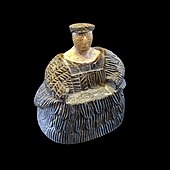


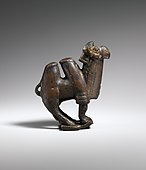
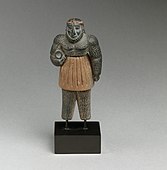





![Decorated tapestry with seated goddess Tabiti and rider, Pazyryk Kurgan 5, Altai, Southern Russia c. 241 BC.[17]](http://upload.wikimedia.org/wikipedia/commons/thumb/9/9c/Pazyryk_presentation_scene.jpg/170px-Pazyryk_presentation_scene.jpg)
![Bronze plaque of a man of the Ordos Plateau, later held by the Xiongnu. 3–1st century BC, British Museum. Otto Maenchen-Helfen notes that the statuette displays Caucasoid features.[19]](http://upload.wikimedia.org/wikipedia/commons/thumb/a/aa/BronzeManOrdos3-1stCenturyBCE.JPG/122px-BronzeManOrdos3-1stCenturyBCE.JPG)
![Belt buckle with Europoid types, Mongolia or southern Siberia, 2nd–1st century BC.[20][21]](http://upload.wikimedia.org/wikipedia/commons/thumb/8/82/Belt_Buckle_LACMA_M.76.97.582.jpg/170px-Belt_Buckle_LACMA_M.76.97.582.jpg)
![Belt Buckle, Mongolia or southern Siberia, 2nd–1st century BC.[20]](http://upload.wikimedia.org/wikipedia/commons/thumb/4/4e/Belt_Buckle_LACMA_M.76.97.583.jpg/170px-Belt_Buckle_LACMA_M.76.97.583.jpg)
![The Boar hunter, with characteristic Xiongnu horse trappings, Southern Siberia, 280–180 BC. Hermitage Museum.[22][23][24]](http://upload.wikimedia.org/wikipedia/commons/thumb/1/17/Steppes_horseman_hunting.jpg/170px-Steppes_horseman_hunting.jpg)
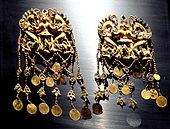
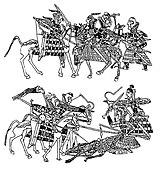
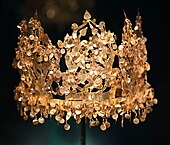















![Figures in the embroidered carpets of the Noin-Ula burial site, made in Bactria and proposed to represent Yuezhis (1st century BC – 1st century AD).[60][61][62]](http://upload.wikimedia.org/wikipedia/commons/thumb/a/a6/Noin-Ula_nobleman_and_priest_over_fire_altar.jpg/183px-Noin-Ula_nobleman_and_priest_over_fire_altar.jpg)
![Kushan worshiper with deity Zeus/ Serapis/ Ohrmazd, Bactria, 3rd century AD.[63]](http://upload.wikimedia.org/wikipedia/commons/thumb/1/1f/Panel_with_the_god_Zeus-Serapis-Ohrmazd_and_worshiper%2C_ca_3rd_century_CE_Kushan.jpg/191px-Panel_with_the_god_Zeus-Serapis-Ohrmazd_and_worshiper%2C_ca_3rd_century_CE_Kushan.jpg)
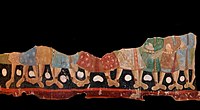
![Painting of a Kushan ruler (probably Huvishka, seated) and attendants, Bactria, 74–258 AD.[64]](http://upload.wikimedia.org/wikipedia/commons/thumb/2/28/Kushan_ruler_and_attendants%2C_Bactria_74-258_CE.jpg/167px-Kushan_ruler_and_attendants%2C_Bactria_74-258_CE.jpg)
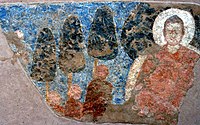

![Kushano-Sasanian footed cup with medallion, 3rd-4th century AD, Bactria, Metropolitan Museum of Art.[68]](http://upload.wikimedia.org/wikipedia/commons/thumb/1/12/Kushano-Sasanian_footed_cup_with_medallion_3rd-4th_century_CE_Bactria_Metropolitan_Museum_of_Art.jpg/200px-Kushano-Sasanian_footed_cup_with_medallion_3rd-4th_century_CE_Bactria_Metropolitan_Museum_of_Art.jpg)
![Possible Kushano-Sasanian plate, excavated in Rawalpindi, Pakistan, 350–400 AD.[69] British Museum 124093.[70][71]](http://upload.wikimedia.org/wikipedia/commons/thumb/9/9a/Silverplate_with_investiture_scene._Sasanian_4th_century_CE%2C_possibly_Afghanistan._Middle_East%2C_52_Ancient_Iran_-_28174064678.jpg/200px-Silverplate_with_investiture_scene._Sasanian_4th_century_CE%2C_possibly_Afghanistan._Middle_East%2C_52_Ancient_Iran_-_28174064678.jpg)

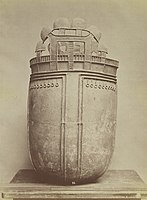
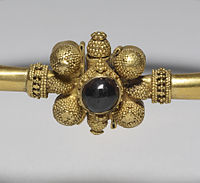
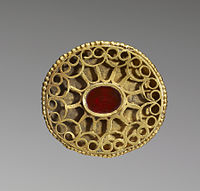

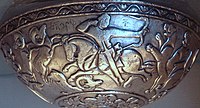

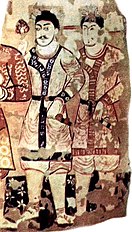

![The banquet scenes in the murals of Balalyk Tepe show the life of the Hephthalite ruling class of Tokharistan.[109][103][104][100]](http://upload.wikimedia.org/wikipedia/commons/thumb/7/7a/Balalyk_Tepe_banquet_scene.jpg/200px-Balalyk_Tepe_banquet_scene.jpg)
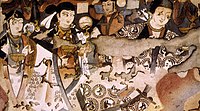
![Probable Hephthalite royal couple in the murals of the Buddhas of Bamiyan circa 600 AD (the 38-meter Buddha they decorate is carbon dated to 544–595 AD).[110]](http://upload.wikimedia.org/wikipedia/commons/thumb/6/69/Hephthalite_sponsors_at_Bamiyan_%28ceiling_of_the_38_meter_Buddha%2C_detail_of_royal_sponsors%29.jpg/200px-Hephthalite_sponsors_at_Bamiyan_%28ceiling_of_the_38_meter_Buddha%2C_detail_of_royal_sponsors%29.jpg)
![Stamp seal with a bearded figure in Sasanian dress, wearing the kulāf denoting nobility and officials; and a figure with radiate crown,[111] both with royal ribbons. Attributed to the Hephthalites,[112] and recently dated to the 5th–6th century AD.[113] Stamp seal (BM 119999), British Museum.](http://upload.wikimedia.org/wikipedia/commons/thumb/3/32/Stamp_seal_%28BM_119999%29_composite.jpg/200px-Stamp_seal_%28BM_119999%29_composite.jpg)
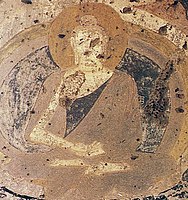

![Probable King of Bamiyan, in Sasanian style, in the niche of the 38 meters Buddha, next to the Sun God, Bamiyan.[102][121][122]](http://upload.wikimedia.org/wikipedia/commons/thumb/5/5f/Painting_of_a_King_in_the_niche_of_the_38_meter_Buddha%2C_Bamiyan.jpg/154px-Painting_of_a_King_in_the_niche_of_the_38_meter_Buddha%2C_Bamiyan.jpg)
![Western Buddha, Niche, ceiling, east section E1 and E2.[123]](http://upload.wikimedia.org/wikipedia/commons/thumb/0/0c/Bamiyan_Western_Buddha%2C_Niche%2C_ceiling%2C_east_section_E1_and_E2.jpg/159px-Bamiyan_Western_Buddha%2C_Niche%2C_ceiling%2C_east_section_E1_and_E2.jpg)
![The mural, "Dance of princess Chandraprabha", with frames probably derived from Roman art of the 1st century AD.[131] Treasure Cave C (Cave 83). MIK III 8443.](http://upload.wikimedia.org/wikipedia/commons/thumb/8/89/Cave_83_painting.jpg/200px-Cave_83_painting.jpg)
![Painting of a cowherd listening to a sermon of the Buddha, from the right wall of the main hall. Cave of the Statues. 14C date: 406-425 AD.[132]](http://upload.wikimedia.org/wikipedia/commons/thumb/2/23/Nanda_the_cowherd%2C_Kizil%2C_Cave_of_the_Statues_%28Cave_77%29%2C_406-425_AD%2C_wall_painting_-_Ethnological_Museum%2C_Berlin_-_DSC01776.JPG/200px-Nanda_the_cowherd%2C_Kizil%2C_Cave_of_the_Statues_%28Cave_77%29%2C_406-425_AD%2C_wall_painting_-_Ethnological_Museum%2C_Berlin_-_DSC01776.JPG)

![Praṇidhi scene, temple 9 (Cave 20), including Sogdian merchants. Bezeklik Caves.[133]](http://upload.wikimedia.org/wikipedia/commons/thumb/d/d9/Bezeklik_caves%2C_Pranidhi_scene_14%2C_temple_9.JPG/148px-Bezeklik_caves%2C_Pranidhi_scene_14%2C_temple_9.JPG)
![Details from Praṇidhi scene No. 5. Central Asian and Asian Buddhist monks.[133]](http://upload.wikimedia.org/wikipedia/commons/thumb/b/b8/Central_Asian_Buddhist_Monks.jpeg/159px-Central_Asian_Buddhist_Monks.jpeg)


![Afrasyab Chinese Embassy (left), carrying silk and a string of silkworm cocoons, and Turkish delegates (right), recognizable by their long plaits.[137][138]](http://upload.wikimedia.org/wikipedia/commons/thumb/2/2d/Afrasyab_Chinese_Embassy_%28left%29_and_Turkish_courtier_%28right%29.jpg/200px-Afrasyab_Chinese_Embassy_%28left%29_and_Turkish_courtier_%28right%29.jpg)
![Ambassadors from Chaganian (central figure, inscription of the neck), and Chach (modern Tashkent) to king Varkhuman of Samarkand. 648-651 AD, Afrasiyab murals, Samarkand.[139][140][141] The delegate to the right has a Simurgh design on his dress.[142]](http://upload.wikimedia.org/wikipedia/commons/thumb/5/5e/Ambassadors_from_Chaganian_%28central_figure%2C_inscription_of_the_neck%29%2C_and_Chach_%28modern_Tashkent%29_to_king_Varkhuman_of_Samarkand._648-651_CE%2C_Afrasiyab_Museum%2C_Samarkand%2C_Uzbekistan.jpg/190px-thumbnail.jpg)
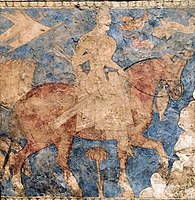
![The Anikova dish: a Nestorian Christian plate with decoration of a besieged Jericho, by Sogdian artists under Karluk dominion, Semirechye. 9th-10th century, derived form 8th century material related to Penjikent.[143][144][145]](http://upload.wikimedia.org/wikipedia/commons/thumb/e/ee/Piatto_con_decorazione_di_castello_assediato%2C_arg%2C_samirechye%2C_da_bolshoe-anikovskaya%2C_IX-X_sec_su_orig_del_l%27VIII_sec.JPG/198px-Piatto_con_decorazione_di_castello_assediato%2C_arg%2C_samirechye%2C_da_bolshoe-anikovskaya%2C_IX-X_sec_su_orig_del_l%27VIII_sec.JPG)
![Gilt silver bowl from Bactria, Northern Wei tomb (439-534 AD).[152]](http://upload.wikimedia.org/wikipedia/commons/thumb/2/2c/Northern_Wei_Gilt_Silver_%2810100940894%29.jpg/150px-Northern_Wei_Gilt_Silver_%2810100940894%29.jpg)
![A ewer with Greco-Roman scenes from the tomb of Northern Zhou general Li Xian, 569 AD.[149][150] It was probably made in Bactria.[151]](http://upload.wikimedia.org/wikipedia/commons/thumb/1/1e/Northern_Zhou_Gilded_Silver_Ewer_%289833405755%29.jpg/133px-Northern_Zhou_Gilded_Silver_Ewer_%289833405755%29.jpg)
![Gem-inlaid gold ring of Central Asian design, tomb of Xu Xianxiu, 571 AD.[153][154]](http://upload.wikimedia.org/wikipedia/commons/thumb/2/27/Northern_Qi_Gem-inlaid_Gold_Ring%2C_571_AD_%28Tomb_of_Xu_Xianxiu%29.jpg/150px-Northern_Qi_Gem-inlaid_Gold_Ring%2C_571_AD_%28Tomb_of_Xu_Xianxiu%29.jpg)
![Silver artifacts from Khakassia, associated wjth the Yenisei Kyrgyz people.[155]](http://upload.wikimedia.org/wikipedia/commons/thumb/9/96/Yenisei_Kyrgyz_artefacts.jpg/200px-Yenisei_Kyrgyz_artefacts.jpg)

![Shoroon Bumbagar tomb mural, Göktürk, 7th century CE.[156][157][158][159]](http://upload.wikimedia.org/wikipedia/commons/thumb/e/ec/Shoroon_Bumbagar_tomb_mural%2C_7th_century_CE%2C_Mongolia.jpg/200px-Shoroon_Bumbagar_tomb_mural%2C_7th_century_CE%2C_Mongolia.jpg)
![An early Turk Shahi ruler named Sri Ranasrikari "The Lord who brings excellence through war" (Brahmi script). In this realistic portrait, he wears the Turkic double-lapel caftan. Late 7th to early 8th century AD.[160][161][162]](http://upload.wikimedia.org/wikipedia/commons/thumb/a/a4/Turk_Shahi_portrait._King_Sri_Ranasrikari._Late_7th_to_early_8th_century_CE.jpg/200px-Turk_Shahi_portrait._King_Sri_Ranasrikari._Late_7th_to_early_8th_century_CE.jpg)
![Decorated niche from the Abbasid mosque of Afrasiab, Samarkand, 750-825 CE.[163]](http://upload.wikimedia.org/wikipedia/commons/thumb/a/a6/Decorated_niche%2C_750-825_CE%2C_Afrasiab%2C_Samarkand.jpg/200px-Decorated_niche%2C_750-825_CE%2C_Afrasiab%2C_Samarkand.jpg)



![Great decorated panel from a Samanid residential complex, 9th-10th century, Afrasiab, Samarkand.[165]](http://upload.wikimedia.org/wikipedia/commons/thumb/2/22/Great_decorated_panel%2C_9th-10th_century%2C_Afrasiasb%2C_Samarkand.jpg/200px-Great_decorated_panel%2C_9th-10th_century%2C_Afrasiasb%2C_Samarkand.jpg)



![Gold ewer of the Buyid Period, mentioning Buyid ruler Izz al-Dawla Bakhtiyar ibn Mu'izz al-Dawla, 966-977 CE, Iran.[167]](http://upload.wikimedia.org/wikipedia/commons/thumb/b/b2/Gold_Ewer_Iran_Buyid_Period_Third_quarter_of_10th_century_CE_%28cleaned_up%29.jpg/141px-Gold_Ewer_Iran_Buyid_Period_Third_quarter_of_10th_century_CE_%28cleaned_up%29.jpg)
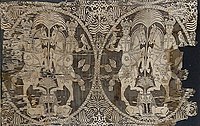
![Rosewater bottle, Buyid art, early 12th century, Iran. Freer Gallery of Art.[168]](http://upload.wikimedia.org/wikipedia/commons/thumb/6/65/Rosewater_bottle%2C_Iran%2C_12th_century%2C_silver_with_gold_and_niello_-_Freer_Gallery_of_Art_-_DSC04655.jpg/134px-Rosewater_bottle%2C_Iran%2C_12th_century%2C_silver_with_gold_and_niello_-_Freer_Gallery_of_Art_-_DSC04655.jpg)
![Kara-Khanid bands of inscription with running animals, Afrasiab, circa 1200 CE.[175]](http://upload.wikimedia.org/wikipedia/commons/thumb/1/1a/Kara-Khanid_bands_of_inscription_with_running_animals%2C_Afrasiab%2C_circa_1200_CE.jpg/200px-Kara-Khanid_bands_of_inscription_with_running_animals%2C_Afrasiab%2C_circa_1200_CE.jpg)
![Bowl with bird. Afrasiab (Samarkand), 11th century.[176]](http://upload.wikimedia.org/wikipedia/commons/thumb/7/75/Bowl_with_bird_-_Uzbekistan%2C_Afrasiab_%28Samarkand%29_-11th_century_-_Reserve%2C_A_-398-1_%3B_KP_1829.jpg/200px-Bowl_with_bird_-_Uzbekistan%2C_Afrasiab_%28Samarkand%29_-11th_century_-_Reserve%2C_A_-398-1_%3B_KP_1829.jpg)
![Bowl with bird. Afrasiab (Samarkand), 11th century.[177]](http://upload.wikimedia.org/wikipedia/commons/thumb/8/80/Bol_-_Uzbekistan%2C_Afrasiab_%28Samarcand%29_-11th_century_-_Reserve_A-49-311_%3B_KP-215.jpg/187px-Bol_-_Uzbekistan%2C_Afrasiab_%28Samarcand%29_-11th_century_-_Reserve_A-49-311_%3B_KP-215.jpg)
![Ghaznavid portrait of a characteristically Turkic individual, Palace of Lashkari Bazar.[182]](http://upload.wikimedia.org/wikipedia/commons/thumb/b/be/Portrait_from_the_Palace_courtroom%2C_Lashkari_Bazar.jpg/153px-Portrait_from_the_Palace_courtroom%2C_Lashkari_Bazar.jpg)
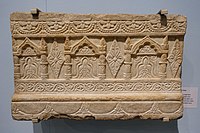


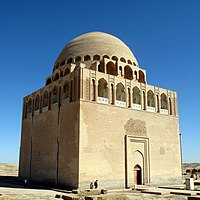

![Princely figure related to the Seljuq sultan or one of his local vassals or successors, Seljuk period, Iran, late 12th–13th century.[183][184]](http://upload.wikimedia.org/wikipedia/commons/thumb/0/0d/Standing_figure%2C_Seljuk_period%2C_Iran%2C_late_12th-13th_century.jpg/104px-Standing_figure%2C_Seljuk_period%2C_Iran%2C_late_12th-13th_century.jpg)
![Mina'i bowl signed by Abu Zayd al-Kashani, dated 1187 CE, Iran.[185]](http://upload.wikimedia.org/wikipedia/commons/thumb/c/cb/Bowl_by_Abu_Zayd_al-Kashani%2C_dated_1187_CE%2C_Iran.jpg/200px-Bowl_by_Abu_Zayd_al-Kashani%2C_dated_1187_CE%2C_Iran.jpg)
![Horsemen, Mina'i ware, early 13th century, Iran.[190]](http://upload.wikimedia.org/wikipedia/commons/thumb/c/c2/Mina%27i_ware%2C_early_13th_century%2C_Iran.jpg/200px-Mina%27i_ware%2C_early_13th_century%2C_Iran.jpg)
![Mina'i Bowl with horserider, early 13th century, Iran.[191]](http://upload.wikimedia.org/wikipedia/commons/thumb/2/28/Mina%27i_Bowl_with_horserider%2C_early_13th_century%2C_Iran.jpg/200px-Mina%27i_Bowl_with_horserider%2C_early_13th_century%2C_Iran.jpg)
![Mina'i Lobed bowl, early 13th century, Iran.[192]](http://upload.wikimedia.org/wikipedia/commons/thumb/e/ec/Mina%27i_Lobed_bowl%2C_early_13th_century%2C_Iran.jpg/199px-Mina%27i_Lobed_bowl%2C_early_13th_century%2C_Iran.jpg)


